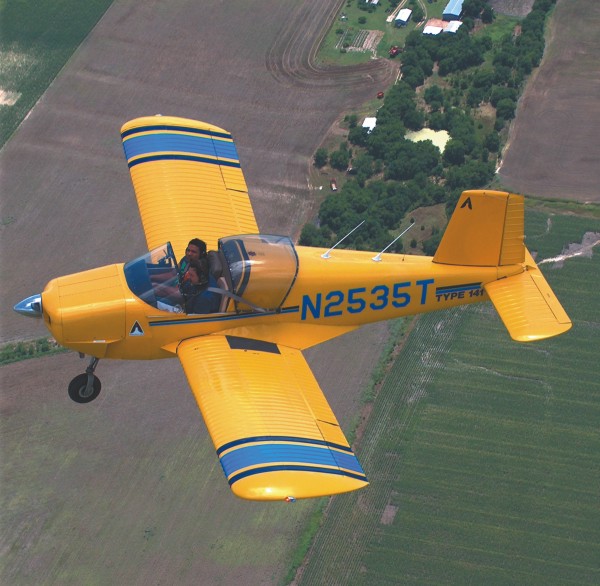
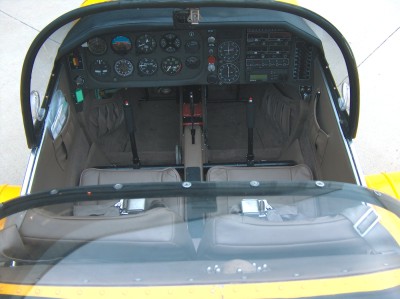
CLASSIC GENERAL AVIATION – It doesn’t resemble the cockpit of many ultralights but it looks, and is, very comfortable. Leather appointments and carpeting throughout make the interior a lower-noise environment.
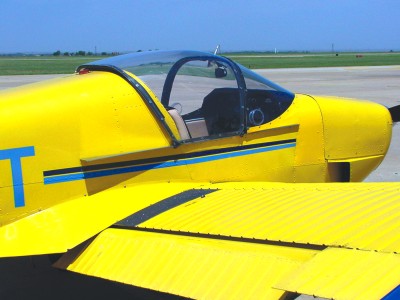
SMOOTHER FLOW – The ribbed wings help limit spanwise flow that can detract from efficiency but note the big strake at the root (plus one at the front this view doesn’t show). They work together to make the T-211’s 25-foot span wing more effective.
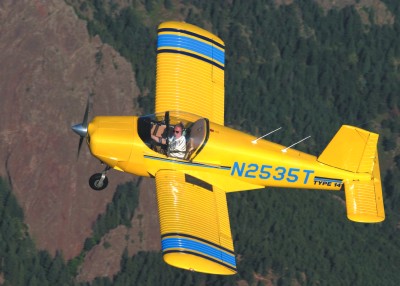
TIGHT SHIP – It looks like a little Cherokee and it should; the designer did the preliminary work for the Piper product. The ribbed skin of wings and tail are a distinctive quality that eases building and aids aerodynamics of the wing. – Photo by Cliff Rock.
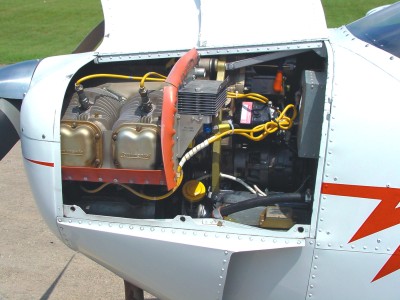
CONTINENTAL POWER – The 4-cylinder Continental O-200 powers the T-211, though the 120-hp Jabiru 6-cylinder engine may be a better choice for those operating under the proposed Light-Sport Aircraft rule or the Amateur-Built rule.
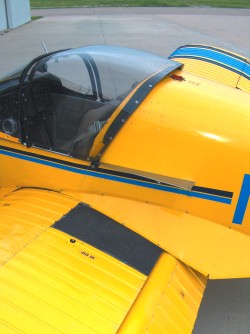
GET ON & PUT IN – Entry is standard walk-on-the-wing style (where permitted). Standing on the wing also makes fueling easy through a filler cap just aft of the closed canopy.
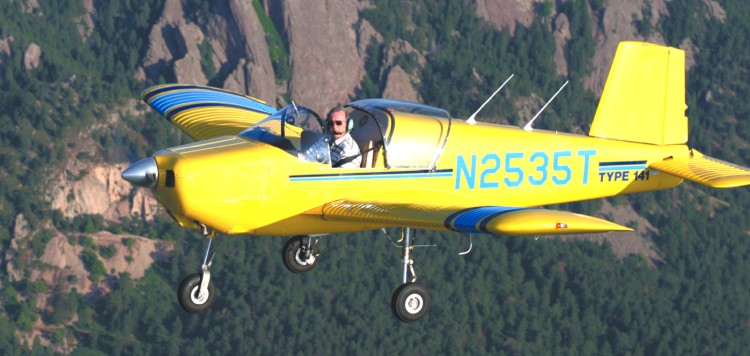
SMELL THE AIR! – You can open the T-211’s canopy in flight for a sense of open cockpit familiar and dear to many ultralight enthusiasts. – Photo by Cliff Rock.
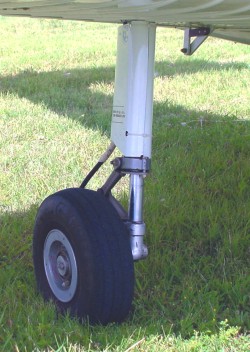
STOUT GEAR – The T-211’s gear supports the airplane with a wide stance that is very secure in taxiing and landing. Note the wing ribbing goes around to the underside as well as the upper surface.

FIRST-CLASS SEAT – If you owned this airplane, here’s your view during flight. All controls are convenient and several pockets are available to hold stuff you want while flying.

LEVER ARMS – Besides dual centered control sticks, the T-211 has a brake lever in the center with flap lever to the right of the fuel shut-off. Note the trim wheel to the left of the brake lever.

LUGGAGE AREA – Aft of the seats is this luggage area in the T-211 providing space for up to 40 pounds of luggage, complete with a webbing restraint system to help keep gear in the space.
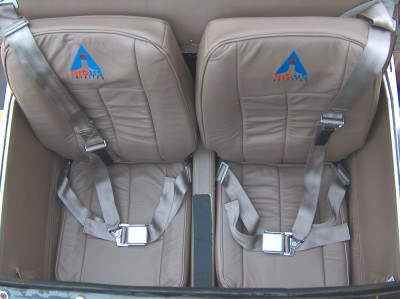
CUSHY COMFORTS – Just like your deluxe automobile, the Thorp T-211 comes with leather seats and fully adjustable shoulder belts. Though a snug fit for big folks, the interior is quite comfortable.

EXPLODED DIAGRAM – This view shows the elements of the design quite clearly. The upper drawing reveals the control linkage system near the cockpit.

PROLIFIC DESIGNER – Before his death in 1992, John Thorp was productive through 80 years of life. He worked for Lockheed, gave Piper the predecessor to the Cherokee line, created the popular T-18 homebuilt, and the T-211 series.
Thorp T-211 Sport E
From the world of general aviation aircraft comes an entry to the proposed Light-Sport Aircraft (LSA) category. Presently known as the Thorp T-211, the all-metal airplane will be called the Thorp T-211 Sport E when it makes its debut as a light-sport aircraft.
Famed designer John Thorp is perhaps best known for his work leading to the Piper Cherokee series and the T-18 homebuilt. His work on a design that became the T-211 started back in the 1940s before general aviation planes had transportation as their primary goal. When the T-211 was first created – as the T-11 Skooter and later the T-111 – it was intended to become competition for the Cessna 150. The T-211 is a light plane, tipping the scales at hundreds of pounds less than Cessna’s smallest model and so it was expected to perform better.
Under new management since 2003, Thorp’s design is ready to make the leap to the Sport E. More than just a clever renaming of the older model, a new powerplant and further reduced weight will significantly transform the Sport E. The result could be a plane that appeals to ultralight pilots as well as general aviation pilots looking harder at sport flying once FAA’s new rule is announced.
Rich In History
I flew the T-211 with Jason Stone, a Citation pilot for an English businessman involved with IndUS Aviation. IndUS has acquired the production rights, tooling, and all available inventory of parts and spares for the Thorp T-211.
A Texas surgeon named Ram Pattisapu formed IndUS Aviation. Born in India, Pattisapu and his family immigrated to the USA when he was 13 years old. Working as a surgeon since the 1980s, he is a 1,000-hour private pilot with instrument and multi-engine ratings.
After owning five different aircraft and experiencing many others, Pattisapu found he wanted to work in the field of aviation and left the practice of medicine. Before starting IndUS Aviation, he says he patented two devices designed to enhance aviation safety.
IndUS Aviation is an American company, established in 1994. Thanks to his Indian roots, Pattisapu formed a working partnership with Taneja Aerospace and Aviation, Limited (TAAL), of Bangalore, India. TAAL is a leading Indian aircraft manufacturer, building the 6-seat, twin-engine, Partenavia-based P68C; an 11-seat twin turbo prop called Viator; an all-composite UAV and numerous aircraft components for other manufacturers. Building the T-211 airframe would appear to be well within TAAL’s capabilities. Completed airframe subassemblies for American sale are shipped to IndUS’ U.S. operation.
For markets outside India, final assembly – including engine fitting, avionics, painting, interiors and flight-testing – will be accomplished at IndUS’ 11,000-square-foot hangar facility at the Dallas Executive Airport in Texas. Many components are sourced in the U.S. IndUS says, “This type of a unique arrangement gives us tremendous flexibility and marked reduction in costs of production, enabling us to deliver highest quality aircraft at the lowest price.”
“IndUS is proud to manufacture the Thorp T-211 Sport E,” says Pattisapu. “We chose the name Sport E to reflect the fact that this FAA type-certified airplane (formerly known as just the Thorp T-211) will be offered for the homebuilder to assemble under the Experimental category (51% rule), as well as the upcoming Light-Sport Aircraft category.”
The design has gone fully international. The United Kingdom has an avid flying club of Thorp aircraft, explaining the British businessman’s interest to acquire the type and production certificate. After years of languishing in its country of origination, IndUS hopes to populate American airports with their side-by-side 2-seater.
The T-211 is certainly no Johnny-come-lately. The model dates back to design studies in the early 1940s that led to the Lockheed Little Dipper, a single-place light aircraft. The latter was followed by a 2-seat pusher called the Big Dipper. By 1945, this plane had evolved to the Sky Skooter, a 75-hp Lycoming O-145-powered aircraft. It earned United States Civil Aviation Authority (CAA) CAR 3 Type Certification.
By the early 1950s, the Sky Skooter acquired a 90-hp Continental C-90 engine. This work led in 1956 to the 180-hp preliminary design for the Piper Cherokee. That storied company eventually built the PA-28 Cherokee with 150 hp. Thorp’s work influenced other designs as well; the 2-place, twin-engine Wing Derringer began life as a twin-engine version of the Skooter.
Thorp’s work led to the T-18 that became popular among homebuilders. In 1960, one of the all-metal, 2-place, high-performance models built by Don Taylor became the first homebuilt to fly around the world.
Finally, in 1963, the FAA Type Certificate for the Sky Skooter was amended to include a 100-hp Continental O-200. This was design designation T-211 for John Thorp.
The prolific designer also worked on a 4-place twinjet using a Williams engine back in the early 1960s. By the 1970s he again worked on a single-place, high-performance sport plane plus a World War I replica and he created a design study for a 2-place, twin-engine aircraft based on the T-18.
Now IndUS takes the venerable T-211 and, with the addition of an Australian engine, introduces the Sport E.
A Closer Look
One of the most distinguishing characteristics of the airplane is the ribbed wing design, a feature also found on other aircraft in the World War II time frame. The ribbing is also found on the horizontal tail surface, which is an all-flying stabilator, quite advanced for its day.
The advantage of the ribbed aluminum wing and horizontal tail is that this construction saves a lot of interior riveting as far fewer internal ribs are used. The wing forms a sort of external structural rib, greatly easing the assembly process.
Sliding canopies aren’t common on general aviation aircraft. Even fewer can fly with the canopy slid back. The T-211 can do so, though, and ultralight pilots might enjoy this configuration for local flights in pleasant weather.
As with the Cherokee or other low-wing general aviation airplanes, you step on the wing, walk forward a step or so and step down into the cockpit. As you do this, you can check the fuel filler cap security as it is located just aft of the canopy. You may stand on the wing for fueling, though this is easily accomplished standing just behind the wing.
Inside the cockpit, you are faced with a familiar general aviation layout which includes a fully finished interior of leather seats, carpeted floors and side walls, plus various elastic-banded stash pockets for aircraft logs, sectional maps, and other items you may want in flight.
Behind you is a large hat rack area that can hold 40 pounds of luggage. A webbed cargo net keeps the gear in place during flight, but it is accessible (at least for those flexible enough to pivot inside the snug-fitting cockpit). The T-211 is about an inch wider than the Cessna 150 but that means two big fellows may not fit inside comfortably.
A flap lever is forward of a centrally mounted hand brake lever. A detent button is used only to release the flaps. To the left of the flap lever is the fuel shutoff.
Two notches of flaps are available, deploying to approximately 15° and 30°. Originally the flaps had a 45° down setting but that proved to be more than is necessary, and it was modified later.
A trim wheel is just to the left of the center console; both sides can reach it easily but the right seat can’t see the setting easily. Each seat has a control stick positioned between the occupant’s legs.
An array of instruments faces the left-seat occupant with power switches and key electric starting on the far left of the instrument panel. Near the center of the panel are engine throttle, choke, and the carburetor heat control. Either seat can reach these without a stretch. Our test T-211 had a nice dual nav/com radio stack with transponder, GPS, and dual VORs. At the extreme right is the fuel panel. Both sides have headphone connections and fresh air controls. All in all, the T-211 has a sensible and efficient cockpit layout.
Both seats have rudder pedals but the center-mounted hand brake is unidirectional. Like most T-211 controls it can be operated easily from either seat and affords good leverage with adequate stopping power.
Skooter in the Air
After Stone performed the preflight and we secured the shoulder belt system around us, we were ready to taxi out for takeoff. On a warm day in Florida, I was happy to leave the canopy open until we were number-one for takeoff.
Launching in 85° heat and damp, humid conditions showed the limits of the Continental O-200 on an aircraft with two slightly-larger-than-average occupants plus full fuel and a panel full of goodies. We climbed only between 300 and 500 fpm on a day with some convective lift and sink occurring.
We flew around at 2,500 feet agl while I familiarized myself with the plane’s controls. In a word: easy. The T-211 and Sport E will impress most pilots with well-harmonized controls that are very light to the touch. While not sensitive and without a particularly fast roll rate, the linkages make handling light and pleasant. Thorp designed with ball bearings throughout his control pushrods and bell cranks, and it shows when you move stick and pedals.
After leaving the busy Lakeland Linder Airport, we flew to Jay and Terri Kurtz’s South Lakeland Airpark. It’s always good to see these friends whose airport I have been using for flight reviews for more than 20 years. When we landed in the T-211, Jay came out to say hello and to check out a general aviation design he hadn’t often seen frequent the 4,000-foot turf strip.
All three landings I performed were good, though you have to operate something like an ultralight and assure adequate speed, which means you may have to speed up a little. That is, you can fly around at 60 mph indicated and feel in full control of the T-211. But Stone advised me to approach at 80 mph indicated, slowing to 70 mph over the runway. These figures seemed somewhat on the conservative side; I feel sure a pilot familiar with the Thorp could bring it in somewhat slower.
Using one notch of flaps for landing didn’t accomplish much. In fact, Stone says the British pilots who fly the T-211 don’t use any flaps. You definitely don’t use any flaps for takeoff as you’ll only add drag.
According to IndUS Aviation, the T-211 can take off in approximately 400 feet. The little bird can land in approximately the same distance so it should feel right at home at most ultralight airparks. With generous clearance afforded by its main gear and nosewheel, you won’t worry about turf runways at all. The T-211 is not presently fitted with wheelpants and I wouldn’t add them.
Go Power
Flying behind a Continental O-200 will be unimpressive to ultralight pilots used to plenty of power and light airframes.
The T-211 uses the Continental 0-200 engine, which puts out 100 hp and burns 5.5 to 6.0 gallons an hour. IndUS says this engine can produce a cruise of 120 mph but we didn’t see those speeds at the lower altitudes we used for this flight review.
However, the 100- to 105-mph cruise we did see in mid-April may not be the limit. Marketing manager Scott Severen reports the 100-horse engine fitted to the Thorp is not flying with that much power. In the Type Certificate, the T-211 is limited to 2,500 rpm of power due to the oil pan installed in this version of the engine. While it is rated to 2,750 rpm – where it gets 100 hp – it cannot be run that hard in the T-211 as it has not been tested at the higher power setting. At its certified limit of 2,500 rpm, the O-200 is outputting about 90% power or 90 hp. This margin makes a significant difference and you can measure it.
Therefore, Severen says the plan is to install a 6-cylinder 120-hp Jabiru 3300 engine in the Sport E. Since the Jabiru weighs between 40 and 50 pounds less than the Continental, the combination of 30 more horsepower and 40 pounds lighter weight should create a lively performer. The company projects speeds close to 130 mph. IndUS has the Jabiru 3300 and will be fitting it in the summer of 2004. They’ll also look at the 80-hp Jabiru 2200 model. While it only produces 80 hp, it weighs another 40 pounds less than the 3300 so it might suffice for use in countries like India where occupants won’t tend to be as large as Americans.
Power-on and power-off stalls were “extremely mild” according to my tape-recorded notes. In several trials, I found no stall showed any tendency to fall on a wing. Neither did they show the slightest tendency to break over.
I flew a power-on stall at full power (well, at 90-hp), a power-off stall entered gently and one entered much more aggressively, plus an accelerated stall. In every case the T-211 showed very mild characteristics. Power-on stall occurred at about 50 mph indicated while power-off stalls occurred at 63 mph indicated.
Sporty Sport E
IndUS is basically offering three versions of the Sport E. One is the fully certified model and they will limit sales of these on an each-case basis. Some flight schools are using the model and others are investigating. Cost is $99,000 for the fully FAR Part 23-certified model.
Next is the Amateur-Built (51%) version. “In addition to manufacturing complete aircraft, IndUS will offer ‘Quick ‘n EZ-Build’ kits for the home- builder. With these kits, nearly half of the assembly process is completed for a cost that is only slightly higher than the basic airframe parts kit,” according to the company. Wing spars, wing-attach points, ribs, top skin and leading edge skins are riveted at the factory. The bottom skin is left off so the builder can install the controls. Flaps and ailerons are finished, and ready for assembly to the wing (except for a few rivets left out to allow inspection). All bulkheads, lower skins and stringers are riveted in place. The top skin is left off so the builder can install the controls, fuel cell, antenna cables, and wiring. The vertical fin, rudder, stabilator, and trim tab are finished and ready for assembly, except for a few rivets left out to allow inspection.
The EZ-Build Kit includes all parts to finish the airframe firewall aft. Parts are predrilled using matched-hole tooling. All aluminum parts are coated with corrosion protection. Also included are wing tips, stabilator tips, push/pull tubes for ailerons and stabilator controls, rudder pedals, control cables and control horns, Cleveland-style wheels and brakes with 5.00 X 5 tires, pop-out circuit breakers, fuel cell, canopy, and windscreen.
“We also offer Rapid Fire builder-assistance programs at our Dallas facility,” says IndUS. “This program is unusual in that it actually guarantees that the builder can finish the project within a period of time (for example, buy at Sun ‘n Fun, fly by Oshkosh; or buy at Oshkosh, fly by Sun ‘n Fun).”
Explaining their unique program more fully, Severen says, “In the Rapid Fire Program you will spend up to seven building “weekends” of four full days each (8 hours per day, Friday through Monday or Monday through Thursday) at the IndUS factory in Dallas, Texas. You will receive comprehensive training in all the building techniques required to complete your Thorp Sport E, along with the assistance of the experienced staff.”
Under the Rapid Fire Program you’ll receive working space in IndUS’ shop, access to their A&P IA staff and use of company tools, plus they’ll arrange lodging. The cost is normally $8,250 when purchased with kit though special opportunities are occasionally offered; check with the factory for more information.
The Sport E kit includes a 120-hp Jabiru 3300, basic paint in their “house” white or yellow paint scheme, and standard day VFR instruments. “Extras, bells, whistles, and fancy paint or graphics must be added separately,” says IndUS.
A Sport E kit runs $25,000 not including the engine, prop, instruments, paint or interior. “Typically these finish items will equal the cost of the airframe kit, or another $25,000,” says Severen. Still the kit is the lowest-cost way to acquire the Sport E and the price is competitive with other airplanes in this class. Since it is not efficient to manufacture parts for certified and kit models separately, all Sport Es come with parts off the certified production line, though the kits will not receive the compliance certificate.
Finally comes the Sport E for Light-Sport Aircraft.
Pattisapu says, “Once the eagerly awaited Light-Sport Aircraft rule is in place, we will recertify our Sport E under the new category. Since this airplane is already type-certified under an FAA standard-category airworthiness certificate, we anticipate being able to comply with the requirements for the new category fairly quickly.”
Cost for the completed ready-to-fly Sport E in the Special Light-Sport Aircraft category is projected at $70,000. For an all-metal airplane that has won a higher level of certification, and equipped with the 120-hp Jabiru 3300, this is competitive with other proposed higher-end LSAs.
“All the required tooling for the parts needed to assemble this aircraft, as well as enough manufactured parts to produce the first 25 such aircraft have been obtained,” says IndUS.
The only thing the Sport E lacks is you. Are you ready?
| Seating | 2, side-by-side |
| Empty weight | 775 pounds |
| Gross weight | 1,270 pounds 1 |
| Wingspan | 25 feet |
| Wing area | 104.6 square feet |
| Wing loading | 12.1 pounds/square foot |
| Length | 18.25 feet |
| Cabin Interior | 40 inches |
| Height | 6 feet 1 inch |
| Fuel Capacity | 21 gallons |
| Baggage area | hat rack, 40 pounds |
| Kit type | Fully assembled or kit 2 |
| Build time | 400-500 hours |
| Notes: | 1As tested; with 120-hp Jabiru 3300, weight will meet proposed 1,232 pounds. If more weight allowed on rule passage, useful load increases at 1,270 pounds. 2 Fully assembled as a certified aircraft or Special Light-Sport Aircraft (when approved) or as an Amateur-Built (51%) kit. |
| Standard engine | Jabiru 3300, six cylinder 1 |
| Power | 120 hp (100 fior Continental) |
| Power loading | 10.6 pounds/hp (12.7 Continental) |
| Max Speed | 132 mph |
| Cruise speed | 75-120 mph |
| Stall Speed | 52 mph |
| Never exceed speed | 156 mph |
| Rate of climb at gross | 750 fpm |
| Service Ceiling | 15,300 feet |
| Takeoff distance at gross | 450 feet |
| Landing distance at gross | 495 feet |
| Range (powered) | 460 miles (4 hours) |
| Fuel Consumption | 5.0 gph |
| Notes: | 1 or Continental O-200. As tested; proposed Light-Sport Aircraft version will use 120-hp Jabiru 3300 engine and climb may be even stronger than listed. 2In test flight, max climb 500 fpm on a warm, humid day. |
| Standard Features | Continental O-200 engine producing 100 hp, electric starter, Sensenich metal prop, basic engine instrumentation, fully enclosed cabin with canopy that can be opened in flight, dual joysticks, two-position flaps, in-flight trim, panel-mounted choke, convenient fuel shut-off, oleo-strut gear, steerable and suspended nosewheel, single-lever mechanical brakes, ball-bearing control linkages, all-metal wings and tail, shoulder belt restraints. |
| Options | Jabiru 3300 engine (LSA or 51% model), additional flight and navigation instruments and radios, fully assembled option (under proposed Light-Sport Aircraft), and ballistic parachute in development. |
| Construction | All-metal aluminum airframe, special ribbed aluminum wing skins and horizontal tail. Made in India by American-owned company; distributed by U.S.-owned company. |
Design
Cosmetic appearance, structural integrity, achievement of design goals, effectiveness of aerodynamics, ergonomics.
Pros – Proven design from a legendary designer (Thorp designed the Cherokee line). Appropriate for any new pilot and should please many veterans (at least with the larger engine option on LSA or 51% versions). Designed for ease of assembly, keeping prices lower. Unique ribbed wing distinguishes this little plane.
Cons – Payload is fairly slim if a full fuel load is taken aloft. Basic performer compared to many sport planes (though 120-hp Jabiru 3300 engine should change performance and useful load noticeably).
Systems
Subsystems available to pilot such as: Flaps; Fuel sources; Electric start; In-air restart; Brakes; Engine controls; Navigations; Radio; (items covered may be optional).
Pros – Given a general aviation heritage, systems on the T-211 are like most general aviation airplanes, though a bit simpler. Flaps, trim, electric starting are all standard. Flap lever position gives good leverage for ease of operation. Though a simple airplane, the T-211 is well appointed among sport aircraft. Excellent radio stack in test aircraft.
Cons – Engine access means removing cowling, much more time- consuming than on exposed engine ultralights. Flaps are not particularly effective surfaces. Single hand brake is uncommon in general aviation-type aircraft (though ultralight pilots will accept it readily). Trim is a by-feel control for right-side occupant.
Cockpit/Cabin
Instrumentation; Ergonomics of controls; Creature comforts; (items covered may be optional).
Pros – Dual control sticks between occupants’ legs, easy reach and comfortable. Large, easily reached trim wheel (left of center console). Fuel tank fills from the outside and no fumes were noted inside. Comfortable, leather upholstered seats with fully adjustable shoulder and lap belts.
Cons – Cozy interior only 1 inch wider than a Cessna 150 (which most regard as snug). Entry means stepping up on a wing and then lowering yourself into a small cockpit (though comfortable enough once inside). Seats don’t adjust; neither do rudder pedals – especially big folks should try it on for size.
Ground Handling
Taxi visibility; Steering; Turn radius; Shock absorption; Stance/Stability; Braking.
Pros – Huge visibility for preflight traffic checking. Very good ground maneuverability despite lack of directional control help from brakes. Hand brake lever is very accessible for both occupants; lever position affords good grip and pull range. Oleo struts on mains and nose.
Cons – Hand brakes mean no directional control from brake system (though the T-211 hardly seems to miss this). Brakes didn’t seem overly strong (though this is not uncommon). No other negatives.
Takeoff/Landing
Qualities; Efficiency; Ease; Comparative values.
Pros – Very simple and straightforward landing; all three landings I made were good without special effort. Superb visibility on landing approach and before takeoff. Responsive controls make crosswind operations very straightforward. Slips were reasonably effective. Good ground clearance.
Cons – Assuming stall at 50 mph, landing approaches should be made at about 60 mph, a little fast for some ultralight airparks. Ground roll was longer and climbout rather sluggish in the O-200-powered T-211 (though the Jabiru 3300 should change this significantly). Flaps don’t help landing approaches too much; I was advised not to bother with them.
Control
Quality and quantity for: Coordination; Authority; Pressures; Response; and Coupling.
Pros – Well-harmonized controls adequate for use by less experienced pilots yet appreciated by experts. Handling is very predictable with precision turns to headings easy to do. Linkages are smooth, supported by ball bearing construction. Slow-speed handling is quite good.
Cons – Coordinated use of the controls is recommended (as on most aircraft). Roll rate is not brisk; 45°-to-45° turns were in the 4-second range. No other negatives.
Performance
Climb; Glide; Sink; Cruise/stall/max speeds; Endurance; Range; Maneuverability.
Pros – Slow-speed performance capabilities are quite good (though not as slow as some ultralight pilots may prefer). Cruise with Jabiru 3300 is expected to be 130 mph, near max as a LSA – this engine will make the Sport E much more ultralight-like performance- wise. Slow flight qualities were very predictable.
Cons – Climbout with the 0-200 won’t inspire many ultralight pilots based on 300- to 500-fpm. Cruise speeds are modest for what looks like a general aviation airplane. Fuel burn is 5.5 to 6 gph with Continental engine (though this may improve with the Jabiru engine selection).
Stability
Stall recovery and characteristics; Dampening; Spiral stability; Adverse yaw qualities.
Pros – Longitudinal stability was what you’d expect for a Part 23-certified aircraft; disturbing the pitch resulted in level flight again in a short time. Stalls in all forms were very mild and showed no negative characteristics. Though it’s not stability related, the T-211’s excellent visibility is good for overall safety.
Cons – Stall speeds are higher than most ultralights (though a lighter LSA version may fare better in this area). Nosed over, the T-211 picks up speed quite rapidly. Flaps were not particularly effective in steepening landing descents.
Overall
Addresses the questions: “Will a buyer get what he/she expects to buy, and did the designer/builder achieve the chosen goal?”
Pros – Fully certified, just like a Piper Cherokee; should satisfy many general aviation pilots which could aid resale (and acceptance at airports). Can be flown with canopy open, a plus for ultralight enthusiasts. Should easily be approved for LSA based on higher-level Part 23 certification. Kit is said to be an easy build; manuals have been well regarded by builders.
Cons – The T-211’s strength is also its weakness; it may be too general aviation-like for ultralight pilots (though a great choice for general aviation pilots). Though design has a long history, it has not mustered a large following. No local dealer support at this time. Prices are on the high end for ultralight enthusiasts.


My dad actually help with the wing design when he work for Thorp back in the mid 90s. They built the plane in Sturgis, KY they offer to move us to Arizona where they were relocating the company. My dad passed away June 27th of this year. While cleaning out my dad’s office my sister found some of the old information and a couple of diagram posters.
Hey Michel, not sure if you’ll get notified of this post but if you do I’d like to connect. I just acquired T-211 N91312 SN 3, built/owned by John Thorp. I’m scouring the internet looking to learn more and connect with others that know about the plane. Please reach out if you would like to connect.
I have a 2005 Indus Thorp T211. It has a blown Jabiru 3300 engine in it. It had a catastrophic engine failure due to swallowing an exhaust valve. After much research, I have decided to relicense it experimental & install a Cont O-200.
Do you know if anyone else has done this?
Do you know if the motor mount pick- up points on the Indus T211firewall are identical to Continental Thorp T211s?
Are the airframes of the Indus T211s identical to the Continental powered Thorp T211s?
I am wondering if the Motor mount from a Continental powered Thorp T211 will mount directly to a Indus T211 firewall.
Do you know where I can buy a motor mount for a Continental powered Thorp T211?
Is there an organization for Indus Thorp T211s and/or Continental Thorp T211s?
Any information you can provide would be extremely appreciated. My phone is 206-321-5565.
I was pleased to put you in touch with someone that may answer some of these questions.